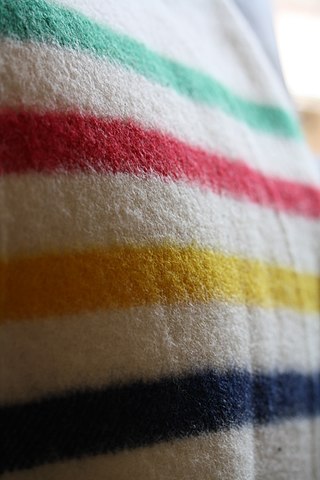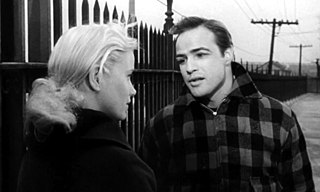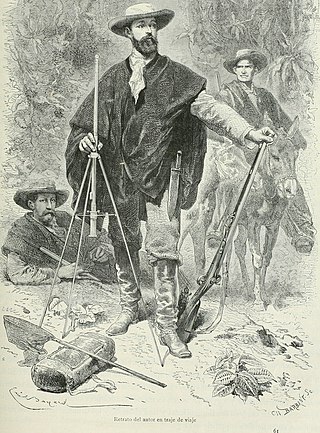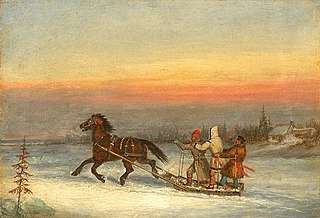
The mackinaw jacket, also known as a mackinaw coat, [1] is a short double-breasted coat made of a thick heavy woollen material, generally with a red-and-black plaid pattern. [2]

The mackinaw jacket, also known as a mackinaw coat, [1] is a short double-breasted coat made of a thick heavy woollen material, generally with a red-and-black plaid pattern. [2]
The word "mackinaw" is derived from the Odawa Ojibwe language word "Mitchimakinak" meaning a large turtle. [3] When French Canadian fur traders transliterated the word, they spelled it as Michilimackinac but pronounced the final consonant as "aw" Rather than "c". The British later shortened the word and changed the spelling to match the French pronunciation: Mackinaw (though the French spelling was used for Fort Mackinac when constructed in 1780–81). [4]
The origin of the mackinaw jacket is owed to the British Army Captain Charles Roberts, [5] while commanding Fort St. Joseph along the St. Mary's River near Sault Ste. Marie. Roberts was unable to obtain military-issued winter greatcoats from his general headquarters (G.H.Q.) located in Montreal, Quebec, for the forty soldiers of the 10th Royal Veterans Battalion [6] under his charge. [7] [8] The date was November 20, 1811, and Captain Roberts, wrote a letter by candlelight to the then Captain Thomas Evans, [9] adjutant general in Montreal, Quebec, making a requisition, written as follows:
"All hopes having now ceased of the arrival of the schooner Hunter or any other vessel from Amherstburg with the clothing of the detachment, I am this day obtaining, upon my requisition to the storekeeper of the Indian Department, a consignment of heavy blankets, for the purpose of making them great coats, a measure the severity of the climate strongly demands and one, I trust, the commander of the forces will not disapprove of when he is informed that not a remnant remains of the coats served out to them in the year 1807 and that they have received none since." – Captain Charles Roberts [10]
To alleviate this health and safety concern, Captain Roberts acquired a supply of 3.5-point Hudson's Bay point blankets and requisitioned John Askin Jr., [11] a Métis and keeper of the King's stores at the fort, to design and manufacture forty woollen greatcoats. [7] [8] In response, Askin hired his spouse and eight to ten local Caucasian and Métis women to sew the forty greatcoats, which were completed and presented to Roberts within two weeks. [10] Everyone was in agreement that the newly tailored greatcoats were of superior quality than the British Army standard issue greatcoats and helped to increase the morale of the King's soldiers. [7]

On July 17, 1812, during the War of 1812, Roberts and his men defeated Captain Porter Hanks [12] and the 61 men of the 1st American Artillery Regiment [13] during the siege of Fort Mackinac [14] [15] and then occupied Fort Mackinac [16] located near present-day Mackinaw City, Michigan. [7] [8] Roberts ordered a new supply of Hudson's Bay point blankets from the British Indian Department for the upcoming winter to manufacture more winter coats. The order called for blue coats; however, the number of blue blankets was inadequate and was supplemented with red and black-on-red tartan pattern blankets. [7] This time Roberts had enlisted the aid of professional tailors and seamstresses to produce the greatcoats. [7]
A despatch runner advised that the long length of the greatcoat was impractical for the deep snow drifts when travelling between Mackinaw and Montreal and requested it be replaced by the shorter double-breasted style, which became known as the mackinaw jacket. [7] [17] At first, the mackinaw jacket was produced in blue and was later replaced by the more popular red and black tartan pattern. [7] The new design of the mackinaw jacket was so beneficial for travelling through woods and trails that orders were received from people located from Fort William to Penetanguishene. [7]
More than century later, when the Hudson's Bay Company began to commercially sell point blanket coats the mackinaw jacket remained popular with their customers. [7] [8] [17]
"In regard to clothing for the body, I will say right here that the man who invented the mackinaw jacket or coat should have a medal if alive and if dead a monument; for in no other garment is there so much all-around common sense for outdoor work in cold weather." – A. F. Wallace [18]
The mackinaw jacket created as a child of grim necessity for cold weather conditions had a short rhyme written about it, adapted from Alfred, Lord Tennyson's Charge of the Light Brigade:
In modern times, the mackinaw jacket has proven to be effective cold weather workwear popular among the blue-collar working class including: farmers, fishermen, lumberjacks, longshoremen, trappers and outdoorsmen. [17] The demand for the mackinaw jacket has decreased by the end of the 20th century; however, it continues to be manufactured by several companies including: C.C. Filson Co., Johnson Woolen Mills, Pendleton Woolen Mills [17] and Stormy Kromer.


A parka and anorak is a type of coat with a hood, often lined with fur or faux fur. These two kinds of garments are staple of Inuit clothing, traditionally made from caribou or seal skin, for hunting and kayaking in the frigid Arctic. Some Inuit anoraks require regular coating with fish oil to retain their water resistance. Parkas are typically longer, often extending to the thighs or knees. Anoraks are usually shorter than parkas, often hip-length, and are traditionally a pull-over jacket.
Mackinac or Mackinaw may refer to:

Fort Mackinac is a former British and American military outpost garrisoned from the late 18th century to the late 19th century in the city of Mackinac Island, Michigan, on Mackinac Island. The British built the fort during the American Revolutionary War to control the strategic Straits of Mackinac between Lake Michigan and Lake Huron, and by extension the fur trade on the Great Lakes. The British did not relinquish the fort until thirteen years after the end of the American Revolutionary War. Fort Mackinac later became the scene of two strategic battles for control of the Great Lakes during the War of 1812. During most of the 19th century, it served as an outpost of the United States Army. Closed in 1895, the fort has been adapted as a museum on the grounds of Mackinac Island State Park.

A jacket is a garment for the upper body, usually extending below the hips. A jacket typically has sleeves and fastens in the front or slightly on the side. A jacket is generally lighter, tighter-fitting, and less insulating than a coat, which is outerwear. Some jackets are fashionable, while others serve as protective clothing. Jackets without sleeves are vests.

A blanket is a swath of soft cloth large enough either to cover or to enfold most of the user's body and thick enough to keep the body warm by trapping radiant body heat that otherwise would be lost through convection.

Flannel is a soft woven fabric, of varying fineness. Flannel was originally made from carded wool or worsted yarn, but is now often made from either wool, cotton, or synthetic fiber. Flannel is commonly used to make tartan clothing, blankets, bed sheets, sleepwear, and several other uses.

Mackinac Island State Park is a state park located on Mackinac Island in the U.S. state of Michigan. A Lake Huron island, it is near the Straits of Mackinac. The island park encompasses 1,800 acres (7.3 km2), which is approximately 80% of the island's total area. The park is also within the boundaries of the city of Mackinac Island and has permanent residents within its boundaries. M-185 circles the perimeter of the park as the only motorless highway in the state due to the island's ban of automobiles. The park is governed by the Michigan Department of Natural Resources and the Mackinac Island State Park Commission. On July 15, 2009, the park celebrated its 20 millionth visitor.

A Hudson's Bay point blanket is a type of wool blanket traded by the Hudson's Bay Company (HBC) in British North America, now Canada and the United States, from 1779 to present. The blankets were typically traded to First Nations in exchange for beaver pelts as an important part of the North American fur trade. The blankets continue to be sold by Canada's Hudson's Bay department stores and have come to hold iconic status in the country.

Mackinaw cloth is a heavy and dense water-repellent woolen cloth, similar to Melton cloth but using a tartan pattern, often "buffalo plaid". It was used to make a short coat of the same name, sometimes with a doubled shoulder. These jackets have their origins on the Canadian frontier and were later made famous by Canadian and American loggers in the upper Midwest as workwear during the mid-19th century logging boom.
Pendleton Woolen Mills is an American textile manufacturing company based in Portland, Oregon, United States. It is known for its blankets and woolen clothing.

The Battle of Mackinac Island was a British victory in the War of 1812. Before the war, Fort Mackinac had been an important American trading post in the straits between Lake Michigan and Lake Huron. It was important for its influence and control over the Native American tribes in the area, which was sometimes referred to in historical documents as "Michilimackinac".
Plaid may refer to:

The siege of Fort of Mackinac was one of the first engagements of the War of 1812. A British and Native American force captured the island soon after the outbreak of war between Britain and the United States. Encouraged by the easy British victory, more Native Americans rallied to their support. Their cooperation was an important factor in several British victories during the remainder of the war.

Fort St. Joseph is a former British outpost on the southernmost point of St. Joseph Island in Ontario, Canada, on Lake Huron. The fort consisted of a blockhouse, powder magazine, bakery building, Indian council house and storehouse surrounded by a palisade.

A ruana is a poncho-style outer garment native to the Colombian and Venezuelan Andes. In Colombia, the ruana is the characteristic and traditional garment of the department of Boyacá, initially made by indigenous and mestizo people, although it is also made in the departments of Cundinamarca, Antioquia, Nariño, Bogotá, Santander (Colombia), Norte de Santander and Caldas. In Venezuela it is widely used and made in the Andean states of Táchira, Mérida and Trujillo, used since the colonial times by all Venezuelan inhabitants, currently only in the Andean region its traditional use is maintained.

A capote or capot is a long wrap-style wool coat with a hood.
John Askin Jr. (c1765–1820) was a merchant in the Great Lakes fur trade, officer in the British Indian Department, and government official in Upper Canada and Michigan. He and his wife, Madelaine, are remembered as being instrumental in the invention of the Mackinaw jacket in 1811.
Charles Roberts was a captain in the British Army during the War of 1812. He is best known for his field command of the mixed British-Canadian-First Nations column that captured a United States strongpoint, Fort Mackinac, on 17 July 1812 in one of the opening movements of the war.

A maud is a woollen blanket or plaid woven in a pattern of small black and white checks known as Border tartan, Shepherd's check, Shepherd's plaid or Galashiels grey. It was in common use as an item of clothing in the southern counties of Scotland and the northern counties of England until the early twentieth century.

Canadian fashion refers to the styles, trends, design, and production of clothing, footwear, accessories, and other expressions of fashion in Canada and the polities it is descended from.